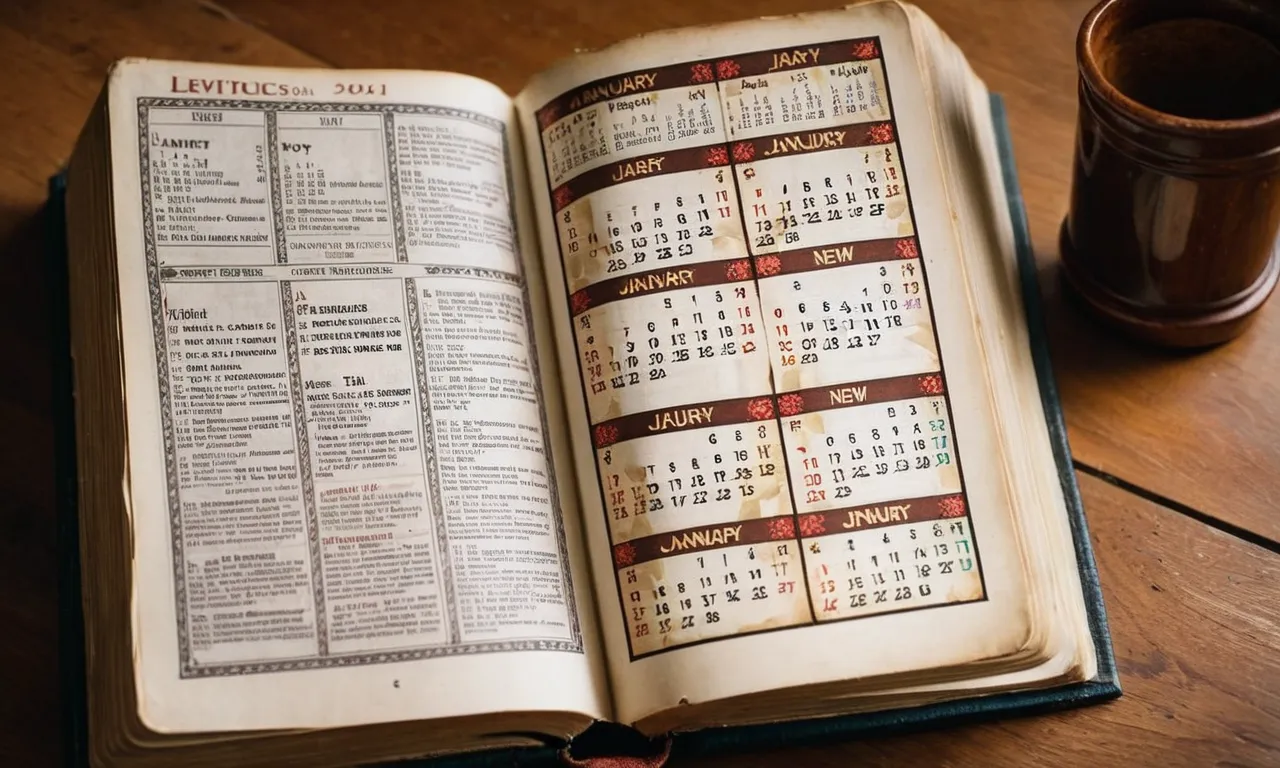When Is The Real New Year According To The Bible?
The celebration of New Year’s Day is a major event across the globe, with parties, fireworks, and countdowns happening on January 1st. But is this when the real new year begins according to the Bible? If you’re short on time, here’s a quick answer to your question: The real new year begins in springtime, not on January 1st.
In this comprehensive article, we’ll dive deep into the evidence from the Bible and Jewish tradition to understand when the true new year begins from a scriptural perspective.
We’ll look at clues from Scripture, the Hebrew calendar, Passover, calculations around Jesus’ death and resurrection, and insights from early church fathers.
By the end, you’ll have a clear understanding of when the real biblical new year starts.
The Hebrew Calendar and New Year in the Spring
The Hebrew Calendar Begins in Spring
The Hebrew calendar, used in ancient Israel and modern Judaism, begins each new year in the spring, not on January 1st like the Gregorian calendar.
According to scripture, God commanded that Nisan, the first month of the Hebrew calendar occurring in the spring, “shall be the first month of the year to you” (Exodus 12:2).
So by biblical reckoning, the new year starts in the season of new beginnings, when vegetation springs forth and new lambs are born.
The Hebrew months are tied to the lunar cycle, beginning with the first sighting of the new moon. So the start of Nisan and the first day of the biblical new year falls somewhere in March or April on the Gregorian calendar.
For example, in 2024 the first day of Nisan and the Hebrew new year fall on March 27th. While January 1st is a relatively arbitrary date to start the year, the Hebrew calendar is connected to seasonal changes and lunar rhythms ordained by God.
Biblical References Point to a Spring New Year
Several key biblical events occurred in the Hebrew month of Nisan, confirming it as the start of the religious year.
God commanded that the Passover lamb be slaughtered on the 14th day of Nisan (Exodus 12:6). This event marked Israel’s Exodus from Egypt after 400 years of slavery.
Beginning Israel’s national history with Passover in the month of Nisan confirms it as the first month.
Later in Israel’s history, King Solomon began construction on the Lord’s temple in Jerusalem “in the second month of the fourth year of his reign” (2 Chronicles 3:2).
This refers to Iyar, the second Hebrew month, showing that the religious new year started in Nisan. Likewise, the account of Nehemiah rebuilding Jerusalem’s walls refers to the month of Nisan as the “first month” (Nehemiah 2:1).
Passover and the Start of the Religious Year
The Exodus Marks the Beginning of the Year
The biblical book of Exodus recounts how God freed the Israelites from slavery in Egypt. This defining moment marked the birth of Israel as a people.
According to Exodus 12:2, God commanded Moses that “This month shall mark for you the beginning of the months; it shall be the first month of the year for you.”
This month is called Nisan in the Hebrew calendar and coincides with March-April.
So the Exodus and Passover represent a new dawn and starting point for tracking years. Just as the Exodus birthed the nation of Israel, Nisan ushers in a spiritual reset and opportunity for rebirth each year.
As one writer put it, “The year begins with the birth of a people and their breakthrough into freedom.” What an inspirational reminder for modern readers!
The Importance of Nisan as the First Month
Several key events occurred in Nisan that give this month special meaning in the biblical narrative:
- God commanded the first Passover sacrifice to protect Israelite homes from the 10th plague (Exodus 12:1-13)
- The Exodus from Egypt took place (Exodus 12:37-42)
- The nation of Israel was born through the covenant at Sinai around the time of Shavuot, occurring 50 days after Passover (Exodus 19)
No wonder this power-packed month kicks off the biblical festival calendar! Echoing Exodus 12:2, the contemporary Jewish calendar likewise continues to observe Nisan 1 as Rosh Hashanah La’Behema, or New Year for Religious Festivals.
This key date commences annual spiritual reflection for Jewish believers. For Christians too, Passover retains deep roots in the Easter season as we remember Jesus Christ’s sacrifice bringing spiritual freedom (John 8:32-36).

Clues from Jesus’ Death and Resurrection
Jesus’ Last Supper was a Passover Meal
The Gospels clearly state that Jesus’ Last Supper with his disciples on the night before his crucifixion was a Passover meal (Matthew 26:17-19).
The Passover celebrates God “passing over” the homes of the Israelites and sparing their firstborn sons from death before the exodus from Egypt (Exodus 12).
It is a springtime festival held on the 14th day of the first biblical month called Nisan. This clues us in that Jesus died around the time of the Passover in early spring.
In the Hebrew calendar, days start at sunset. So when the Gospels say “the first day of Unleavened Bread” (Mark 14:12), they mean the day beginning at sunset after the Passover lambs were slain.
That night, Jesus had the Passover meal with His disciples and instituted the Lord’s Supper as a new memorial feast (Luke 22:15-20). He was crucified the next day, which was still considered Passover.
Insights from Early Church Fathers and Tradition
Early Church Fathers Point to a Spring New Year
The early Church Fathers provide valuable insight into the origins of a spring New Year celebration in the Christian tradition. Several key figures stand out in pointing to a New Year marked in the springtime rather than January 1st.
For example, one of the earliest Church Fathers, Hippolytus of Rome (c. 170-235 AD), wrote in his Commentary on Daniel that “the first month of the year, that is Dystros, begins March 22.” This clearly reflects a New Year date focused in the spring equinox rather than January.
Likewise, Eusebius of Caesarea (c. 263-339 AD) wrote that the New Year began on March 22 in Egypt as an ancient tradition.
He wrote, “even to this day the Alexandrine year dated from the 25th of March begins the new year on that day.”
Furthermore, the early medieval theologian Bede (672-735 AD) provides confirmation of this view, writing that March 25 was considered the first day of the first month in the Hebrew calendar. He wrote, “It is also believed to be the first day of the year…the day when God created light.”
Clearly, key early Church Fathers emphasized a spring dating for New Year’s, rather than January 1st.
The Persistence of a Spring New Year Celebration
Despite the later establishment of January 1st as New Year’s Day in the Julian calendar, early Christian traditions about a spring New Year persisted for centuries.
For example, the Feast of the Annunciation on March 25 commemorated the angel Gabriel’s announcement to Mary about Jesus’ birth. It doubled as the first day of the year in many medieval liturgical calendars. England observed Lady Day on March 25 as the start of the year from the 12th to 18th century.
Likewise, the Feast of the Circumcision of Christ on January 1 emerged much later than a March/April New Year. It only appeared in the 6th century Gelasian Sacramentary texts.
Even after January 1 New Year celebrations began, some areas like Venice, Pisa, and Tuscany in Italy still observed March 25 as the start of the new year in medieval and Renaissance times. The tradition connected to the biblical roots of Passover.
So while January 1 would eclipse March in many areas over time, the spring equinox retained influence as the start of the year in some Christian traditions.
Conclusion
In conclusion, while January 1st is considered the start of the new year on the modern Gregorian calendar, there is significant evidence from Scripture and early Jewish and Christian tradition pointing to a springtime new year instead.
The Hebrew calendar, Passover, events around Jesus’ death and resurrection, and writings of early church fathers all confirm the biblical new year begins in the spring, not on the arbitrary date of January 1st.
As you celebrate the start of the next year, consider how God’s calendar reflects the beauty of new life and redemption found in Jesus Christ.








